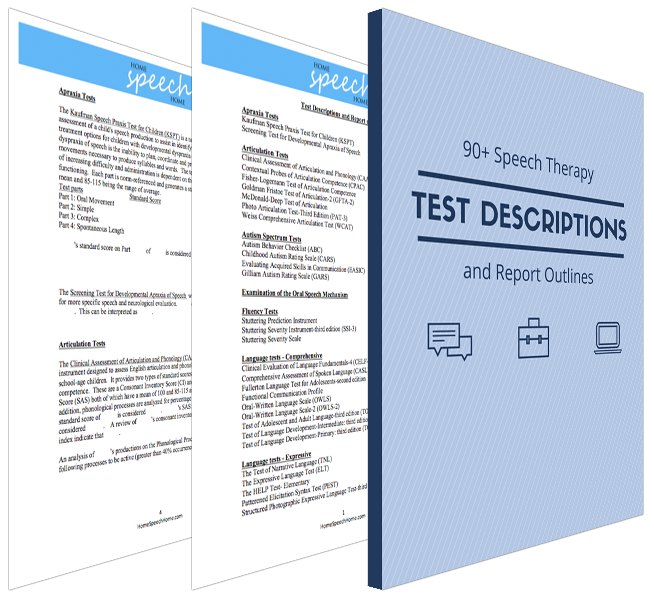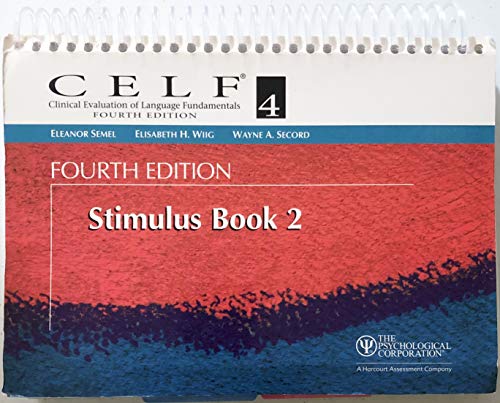- Celf 4 Screener Stimulus Manual Download
- Celf 4 Screening
- Celf 4 Screener Stimulus Manual Template
- Celf 4 Screener Stimulus Manual Instruction
The CELF–4 is sensitive to the language difficulties exhibited by children with intellectual disability or autistic disorder. For more information about the sensitivity of CELF–4 to the language impairments observed in specific clinical groups, refer to pages 273–275 in the CELF–4 Examiner’s Manual. V This field has grown so quickly that even I, an optimist, am stunned. If this test benefits children, which is my dearest hope, there are many people to be thanked—. Includes CELF Preschool-3 Q-global Digital Kit: digital Manual, Stimulus Book and No Juice book, and print No Juice book, Record Forms (pkg 25) and Pragmatics & Preliteracy forms (pad of 50) and CELF Preschool-3 Screening Test (Print) Kit: print Manual (includes Administration Directions, Stimulus Book, and Technical information) and print.
Special recommendations for administering CELF-5 via telepractice
1. Audio/visual environment
- Make sure the full face of the examiner and the examinee is in view during the administration
- A headset with a boom mic for the examiner and the examinee is highly recommended for every CELF-5 assessment via telepractice
- Test the audio either through the examinee's speakers or headset and ensure a high-quality audio presentation, whether live or recorded stimulus prompts
2. Examiner factors
- Practice starting and completing appropriate tests of a CELF-5 assessment before you begin with an examinee
- Make a clinical judgment, similar to a face-to-face session, whether or not you are able to gather the child's best performance. Report your clinical decision(s) in your report and comment on the factors that led to this decision and your reporting or lack of reporting of the scores
3. Examinee factors

- There may be select administrations where an examinee headset is not appropriate or feasible. For this instance, make sure you have a web camera with an embedded microphone or a stand-alone microphone with the volume turned up to a comfortable loudness level
4. Test/test materials
- Make sure you have only one (1) image of the stimulus pictures showing to the examinee at any time
- Go to 'full screen' with the stimulus pictures to eliminate distractions on the desktop/video window within the telepractice environment for the examinee
- The tests that have no visual stimulus should screen share the appropriate page in the digital stimulus book during the administration (a title page or blank page)
- Four CELF-5 tests (Linguistic Concepts, Following Directions, Recalling Sentences, and Structured Writing) are in the process of being studied and the nature of administering the task by telepractice is more complicated. Descriptive reporting may be warranted if the administration is attempted and documentation of the exact procedures must be fully described in the report
5. Other/miscellaneous
None at this time
Selected research to date
Studies supporting the equivalency of test scores when picture stimuli are displayed to the examinee in a printed manual versus a digital display on a computer screen (in-person administration):
Daniel, M. H., Wahlstrom, D., & Zhou, X. (2014). Equivalence of Q-interactive and paper administrations of language tasks: Selected CELF-5 tests. Q-interactive Technical Report 7. Bloomington, MN: Pearson.
Daniel, M. H. (2012a). Equivalence of Q-interactive administered cognitive tasks: WAIS–IV. Q-interactive Technical Report 1. Bloomington, MN: Pearson.
Daniel, M. H. (2012b). Equivalence of Q-interactive administered cognitive tasks: WISC–IV. Q-interactive Technical Report 2. Bloomington, MN: Pearson.
Studies addressing the use of CELF via telepractice:
Eichstadt, T. J., Castilleja, N., Jakubowitz, M., & Wallace, A. (2013, November). Standardized assessment via telepractice: qualitative review and survey data. Paper presented at the annual meeting of the American-Speech-Language-Hearing Association, Chicago, IL.

Celf 4 Screener Stimulus Manual Download
Waite, M., Theodoros, D., Russell, T., & Cahill, L. (2010). Internet-based telehealth assessment of language using the CELF-4. Language, Speech, and Hearing Services in Schools, 41, 445–458.
Note: Further research may be added over time.
Conclusion
Portions of the CELF-5 may be used reliably via telepractice, as noted above. Further research is underway on the tests where a similar performance between paper and telepractice presentation may be in question. Therefore, you may use the noted CELF-5 tests via telepractice without additional permission from Pearson in the following published contexts:
- CELF-5 Digital Stimulus book on Q-global®
Any other use of the CELF-5 via telepractice requires prior permission from Pearson. This includes, but is not limited to, scanning the paper stimulus books, digitizing the paper record forms, holding the materials physically up in the camera's viewing area, or uploading a manual on to a shared drive or site.
Special recommendations for administering CELF-5 via telepractice
1. Audio/visual environment
- Make sure the full face of the examiner and the examinee is in view during the administration
- A headset with a boom mic for the examiner and the examinee is highly recommended for every CELF-5 assessment via telepractice
- Test the audio either through the examinee's speakers or headset and ensure a high-quality audio presentation, whether live or recorded stimulus prompts
2. Examiner factors
- Practice starting and completing appropriate tests of a CELF-5 assessment before you begin with an examinee
- Make a clinical judgment, similar to a face-to-face session, whether or not you are able to gather the child's best performance. Report your clinical decision(s) in your report and comment on the factors that led to this decision and your reporting or lack of reporting of the scores
3. Examinee factors
- There may be select administrations where an examinee headset is not appropriate or feasible. For this instance, make sure you have a web camera with an embedded microphone or a stand-alone microphone with the volume turned up to a comfortable loudness level
Celf 4 Screening
4. Test/test materials
- Make sure you have only one (1) image of the stimulus pictures showing to the examinee at any time
- Go to 'full screen' with the stimulus pictures to eliminate distractions on the desktop/video window within the telepractice environment for the examinee
- The tests that have no visual stimulus should screen share the appropriate page in the digital stimulus book during the administration (a title page or blank page)
- Four CELF-5 tests (Linguistic Concepts, Following Directions, Recalling Sentences, and Structured Writing) are in the process of being studied and the nature of administering the task by telepractice is more complicated. Descriptive reporting may be warranted if the administration is attempted and documentation of the exact procedures must be fully described in the report
Celf 4 Screener Stimulus Manual Template
5. Other/miscellaneous
None at this time
Selected research to date
Studies supporting the equivalency of test scores when picture stimuli are displayed to the examinee in a printed manual versus a digital display on a computer screen (in-person administration):
Daniel, M. H., Wahlstrom, D., & Zhou, X. (2014). Equivalence of Q-interactive and paper administrations of language tasks: Selected CELF-5 tests. Q-interactive Technical Report 7. Bloomington, MN: Pearson.
Daniel, M. H. (2012a). Equivalence of Q-interactive administered cognitive tasks: WAIS–IV. Q-interactive Technical Report 1. Bloomington, MN: Pearson.
Daniel, M. H. (2012b). Equivalence of Q-interactive administered cognitive tasks: WISC–IV. Q-interactive Technical Report 2. Bloomington, MN: Pearson.
Studies addressing the use of CELF via telepractice:
Eichstadt, T. J., Castilleja, N., Jakubowitz, M., & Wallace, A. (2013, November). Standardized assessment via telepractice: qualitative review and survey data. Paper presented at the annual meeting of the American-Speech-Language-Hearing Association, Chicago, IL.
Waite, M., Theodoros, D., Russell, T., & Cahill, L. (2010). Internet-based telehealth assessment of language using the CELF-4. Language, Speech, and Hearing Services in Schools, 41, 445–458.
Celf 4 Screener Stimulus Manual Instruction
Note: Further research may be added over time.
Conclusion
Portions of the CELF-5 may be used reliably via telepractice, as noted above. Further research is underway on the tests where a similar performance between paper and telepractice presentation may be in question. Therefore, you may use the noted CELF-5 tests via telepractice without additional permission from Pearson in the following published contexts:
- CELF-5 Digital Stimulus book on Q-global®
Any other use of the CELF-5 via telepractice requires prior permission from Pearson. This includes, but is not limited to, scanning the paper stimulus books, digitizing the paper record forms, holding the materials physically up in the camera's viewing area, or uploading a manual on to a shared drive or site.